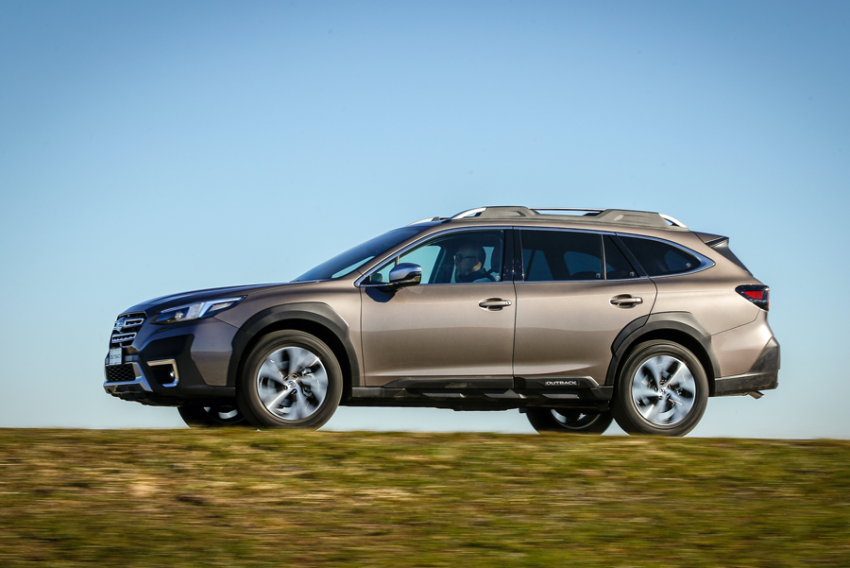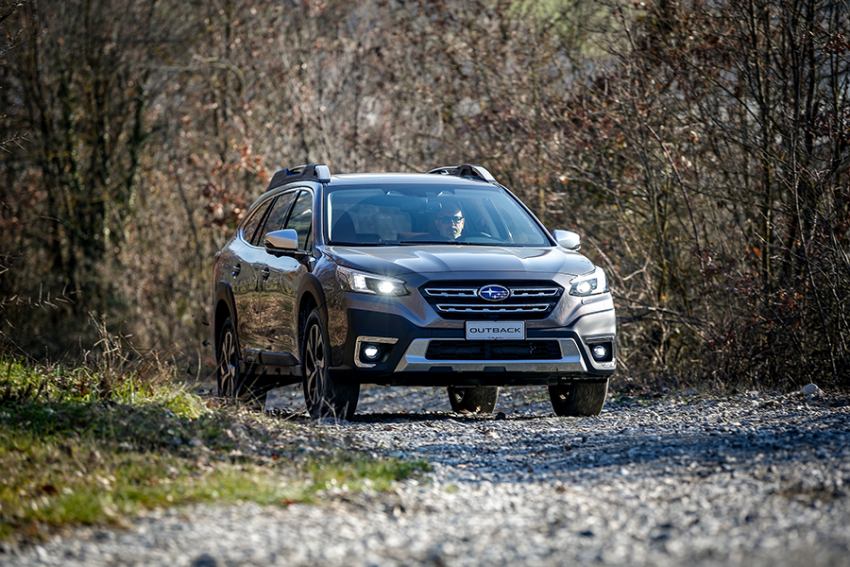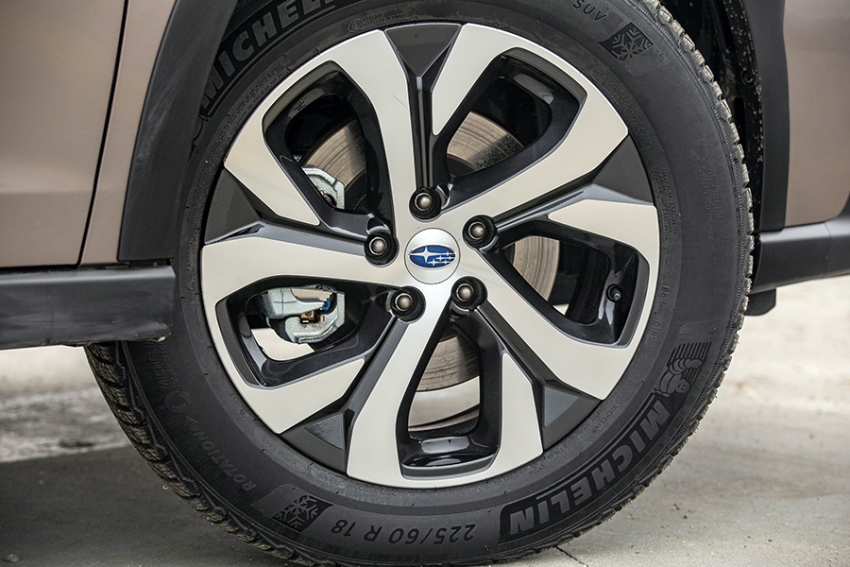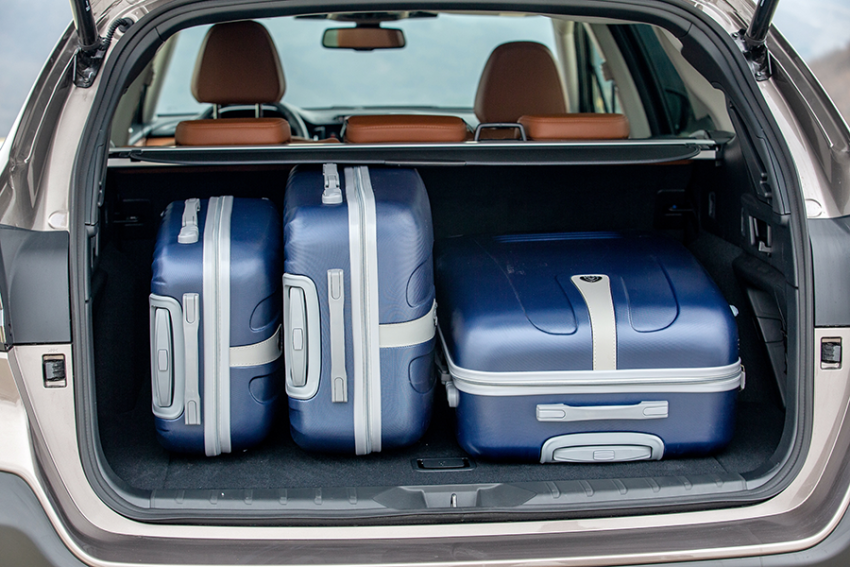For Subaru, represented by the stylized Pleiades constellation that stands out on its oval logo - Subaru in Japanese - symmetrical solutions have always been a priority. Ever since 1966, the year of the launch of the first Subaru 1000 saloon, with a flat engine, the search for balance has been the Japanese brand's chosen path. Right up to the present day. An imprint handed down also to the sixth generation of the Outback, presented in 2021, a crossover first introduced in 1996 on the platform of the then Subaru Legacy and which brings together the characteristics of a 4x4 sport utility and a high-class station wagon.
All-round flagship
At 4.87 metres in length, the Outback occupies the top spot in the current Subaru range, both in terms of size and powertrain options. A supremacy concealed beneath a design that is distinctive yet not excessive, with typical family car lines, a raised roof equipped with roof racks, a large automatic tailgate and robust lower side guards with an off-road look. Not a simple restyling of the previous version (just three years older), but an aesthetic and mechanical upgrade that substantially differentiate the 2021 model year from its predecessors. For example, the new full LED light clusters gives the front of the car a tapered shape, with front and lower air intakes with variable opening depending on the need for engine cooling.
The underbody protections run along the sides enveloping the wheel arches, while seen from the side the Outback conceals its imposing dimensions with stylistic features which include LED rear light clusters and a large upper spoiler. Interior room is guaranteed by the generous dimensions of the vehicle, which is 1.87 m wide, 1.67 m high, and boasts a wheelbase lengthened to 2.74 metres, enough for five passengers, baggage included, thanks to a luggage compartment with a maximum capacity of 1,882 litres.
Inside, two classic circular elements provide the immediate view in front of the driver's seat, supplemented by an MFD screen on which the most useful information are displayed. Central to the dashboard is a large 11.6-inch touchscreen with satellite navigation, Starlink system for network connectivity and all other on-board functions. Faithfull to the most stringent parameters introduced by EuroNCAP, and the presence of several Adas devices, places the Outback at the top of the safety ratings, both active and passive. Automated interventions elaborated by Subaru's EyeSight (using radar, sensors and 360° environmental monitoring cameras) promise to safeguard the vehicle and its passengers, as well as pedestrians and other vehicles, ready to take over when driver reactions fail to avoid a collision. A whole host of acronyms of great utility, including, for example, the Anonymous Emergency Steering function, which automatically steers the vehicle when it detects an imminent impact, or Traffic Sign Recognition with Intelligent Speed Limiter, which not only shows the road signs on the display in front of the instrument panel (MFD - Multi Function Display), but is also able to autonomously adjust speed according to changes in road conditions. But there is more, in fact the Outback 2021 is able to recognise the driver (up to five can be stored in the computer’s memory) and autonomously sets the position of seats, mirrors and other stored settings according to each driver's preferences, as well as triggering alarms and driving line corrections if it detects (from the posture) any episode of distraction or drowsiness.
Only petrol
Bucking the trend of the current automotive market, amidst all kinds of electrified solutions, EVs, mild hybrids, plug-ins and so forth, Subaru chose to remain faithful to its classic flat engine, the most recent evolution of its FB25 Boxer engine, with four horizontally opposed cylinders, 2.5 litre displacement and 16 valve DOHC timing, now with direct fuel injection in addition to the optimisation of almost all of its components. No shortage of power and torque here, with 169 bhp available between 5000 and 5800 rpm and 25.7 kgm at 3800 rpm, giving the Subaru flagship an acceleration from 0 to 100 km/h in 10.2 seconds and a top speed of 193 km/h, with a declared average consumption (in WLTP cycle), also favoured by the Start&Stop system, of 11.6 km/litre, with emissions in the mixed cycle in the order of 193 g/km of CO2.
Simulating gearshifts over eight intervals, the Lineartronic TR58 CVT continuously variable transmission offers a smooth ride, just like a traditional automatic transmission, which can be accessed from a traditional gear stick or paddle shifters next to the steering wheel. By adjusting the setting of two SI-Drive system parameters, one can opt for the smooth ride of the Intelligent Mode or the more dynamic Sport Mode. A must when it comes to Subaru - the world's leading manufacturer of four-wheel-drive cars - and a forerunner with the Leone 4WD of 1972, which was the first mass-produced 4x4 saloon (technology reserved at the time for off-road vehicles only), the most recent evolution of the permanent all-wheel-drive transmission is the Symmetrical AWD system, managed by the sophisticated X-MODE, electronically managed by the Active Torque Split, capable of instantly distributing drive torque between the two axles, depending on grip conditions and selected settings. Furthermore, in case of a sudden loss of grip, the Vehicle Dynamic Control system acts by shifting traction to the outer wheels while braking the inner wheels, automatically restoring the vehicle's correct line.
The mechanical evolution of the sixth generation of the Outback makes use of the SGP platform - Subaru Global Platform - updating several elements aimed at increasing grip and dynamic stability. The MacPherson front suspensions and the powertrain support, now features a boxed cross-member support, replacing the previous engine cradle. This solution has conferred greater structural rigidity for better steering precision (electrically assisted with VGR - Variable Gear Ratio), reduced oscillations, reduction of overall weight and absorption of vibrations caused both by mechanical parts and by contact with the ground. The anti-roll bar increases in diameter from 21 to 24 mm. Also at the rear, the independent, double wishbone suspension has an aluminium subframe, instead of the previous one made of steel, with an 18mm hollow anti-roll bar replacing the 16mm solid one, reducing weight by 460g with a spring constant increased by 1.6 times.
A perfectly aligned longitudinal axis layout of the 4-cylinder boxer engine, CVT gearbox and AWD transmission, together with the lowered centre of gravity of the boxer engine, results in a well-balanced weight distribution, which translates in a responsive yet comfortable ride, despite the 1.6 tons of mass in running order, with a noticeable reduction in body roll when cornering and pitching during sudden changes in speed. Although not a pure off-roader, the Outback's generous 213 mm ground clearance and electronically controlled permanent all-wheel drive with active distribution guarantees a more than adequate traction on all low-grip surfaces, whether snow, mud or natural terrain. Traction is assisted by generous alloy wheels and tyres approved in one size, 225/60 R18, on all trims.








